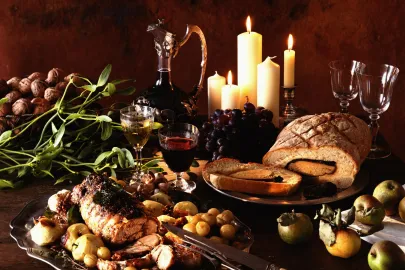Top Chillable Red Wines to Enjoy This Autumn: Perfect for Cooler Days (or Whenever You Feel Like It)
Discover the best chillable French red wines to enjoy as summer turns to autumn. These vibrant, refreshing reds are fuller-bodied than whites or rosés, making them ideal for the autumn transition. Explore our top four red grape picks perfect for chilling and savoring during the cooler days ahead… or whenever you like a refreshing, easy-to-drink red.

With cooler autumn days just around the corner, we’re swapping out our summer whites and rosés for something a bit heartier—enter chillable reds, the ideal style of wine for popping during the summer to autumn transition. Often a bit fuller in body than their bright white and rosé counterparts, these vibrant, acid-forward reds are just as refreshing, though pack a bit more punch for cooler weather days ahead. Curious to dive in but not sure where to start? Check out four of our go-to red grapes for chilling and enjoying during the early days of autumn (or whenever the mood strikes!)
What Are ‘Chillable’ Reds?
While any red wine can technically be “chillable,” most industry professionals agree that chillable reds are wines with high acidity and low tannins—think of them like fuller-bodied rosés, just with a bit more oomph.
Why Are Chillable Reds Great for Early Autumn?
Chillable reds are great for early autumn, as their high acidity and low levels of tannins make them perfect for pairing with a variety of seasonal fare, including root vegetables, stews, pot pies, cheese / charcuterie boards, and more. Additionally, chillable reds offer the perfect segue from refreshing summer whites and rosés to heartier red wines, making them the perfect choice for bridging the gap from warm weather temperatures to chillier temperatures.
How Are Chillable Reds Best Enjoyed?
Chillable reds are some of the most versatile red wines out there, as they make great companions to a variety of dishes, yet are generally light bodied enough to equally be enjoyed on their own. For ringing in the autumn, we particularly love sipping chillable reds outdoors on a porch at sunset or huddled around a fireplace with friends.
Why Are Chillable Reds Increasing in Popularity?
Due to the common grape varieties used to make them, chillable reds are generally lower in alcohol, which render them more pleasing to a variety of palates. Additionally, the high acidity and low tannins found in chillable reds render them extremely versatile on the table, as well as suitable for solo sipping due to their easy drinkability. In short? You can’t go wrong here!
Four Red Grape Varieties Perfect for Chilling This Autumn (Or Whenever You Feel Like It)
Gamay
Synonymous with France’s Beaujolais region, Gamay is a purple-skinned grape variety known for making energetic, fruit-forward wines that are delightful to drink when slightly chilled. Most of Beaujolais’ Gamay is produced using a technique called carbonic maceration, which allows fermentation to begin within the grape berries themselves (versus grape juice post-crushing of the fruit). This technique results in low-tanning, fruit-forward final wines—AKA, those prime for drinking chilled. Fun fact: More than 75% of the world’s Gamay is produced in France. Gamay generally produces light to medium-bodied wines with high-toned aromatics and signature flavors of sour cherry, strawberry, red flower petals, and white pepper.
Regions / appellations to seek out: Beaujolais (the 10 crus : Saint-Amour, Juliénas, Chénas, Moulin-à-Vent, Fleurie, Chiroubles, Morgon, Régnié, Brouilly, and Côte de Brouilly, plus Beaujolais-Villages), Loire Valley (Touraine)
Pinot Noir
Pinot Noir is one of the most beloved—and widely planted—varieties in the world, though the grape is most synonymous with its birthplace of Burgundy. The variety is known for its thin skins and tight clusters, which means it requires a good amount of TLC in the vineyard. However, these thin skins and low levels of phenolic compounds result in light to medium-bodied wines with bright acidity and low levels of tannins, making them perfect for enjoying slightly chilled. Pinot Noir-based wines are most commonly associated with flavors of cherry, raspberry, earth, and mushroom, rendering them ideal components for pairing with equally earthy stews, casseroles, and savory pies. Fun fact: Pinot Noir gets its name from the words pin (pine cone, which references the cluster shape) and noir (black, the color of the skins).
Regions / appellations to seek out: Burgundy (appellations within the Côte de Nuits, Côte de Beaune, and Côte Chalonnaise), Loire Valley (Sancerre Rouge), Alsace (various crus)
Pineau d’Aunis
Although less popular than Gamay and Pinot Noir, Pineau d’Aunis is one of the most chillable red wines in the world. Similar to the latter, Pineau d’Aunis also grows in tight, pine cone-shaped clusters, and also thrives in clay and/or limestone-rich soils. Varietal Pineau d’Aunis wines are known for their flavors of cherry and candied strawberry, as well as its signature note, white pepper. While planted throughout the Loire Valley, Pineau d’Aunis is found mostly in the middle section of the region.
Regions / appellations to seek out: Loire Valley (Anjou, Touraine, Saumur), Vin de France (often sold outside of appellation designations)
Poulsard
Don’t let its dark skins fool you! Despite their very dark hue, Poulsard grapes are known for making light, pale-hued red wines marked by soaring levels of acidity. The grape is most associated with France’s Jura region—where it also goes by the name Ploussard—and thrives in shale, marl, or clay-limestone soils. Like Pinot Noir, Poulsard is also an early ripening variety, and also grows in compacted bunches. Due to its very light nature, Poulsard is frequently blended with other red grape varieties, including Trousseau and Pinot Noir, though on its own, is known for its flavors of cranberry, strawberry, crunchy red plum, black tea, and hibiscus.
Regions / appellations to seek out: Jura (Arbois, Côtes du Jura, and more)
Contributor

Editor













